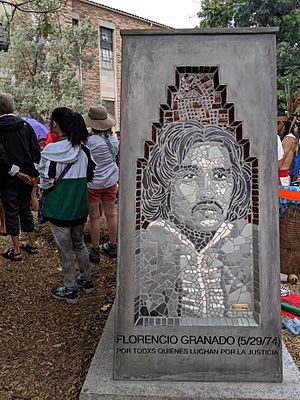Los Seis de Boulder facts for kids
Los Seis de Boulder (meaning The Boulder Six) were six young Chicano activists and students. They died in two separate car bombings in Boulder, Colorado, in May 1974. The name Los Seis de Boulder was given to them after their deaths. These students were protesting how Mexican-American students were treated at the University of Colorado, Boulder. Years later, a monument was built for them in Chautauqua Park on May 27, 2020.
Contents
Student Activism
Los Seis were active members of UMAS (United Mexican American Students) at the University of Colorado Boulder. In the 1960s and 70s, Colorado was one of the first states where Chicano students started groups like MEChA. Chicano is a term some Mexican Americans used for themselves, especially during the Civil Rights Movement.
These groups first focused on making education better for Mexican American students. Over time, they also joined protests against bigger issues. These included police brutality and the U.S. war in Southeast Asia. Today, UMAS and MEChA at the University of Colorado Boulder have joined together. They are now called "UMAS y MEXA."
Before the Bombings
In 1974, there was a lot of tension in Colorado, especially in Denver and Boulder. Over the past year, at least 10 bombings had happened. These bombings mostly targeted public buildings like schools and police stations.
Two months before Los Seis died, a police station in Boulder was bombed in March 1974. No one was hurt, but it caused a lot of damage. Minutes later on the same day, the courthouse was also bombed.
The Car Bombings
First Bombing
The first bombing happened on May 27, 1974. It took place at Chautauqua Park. The explosion was so loud that people all over Boulder heard it.
Three people died in this first car bombing:
- Reyes Martinez, 26, a lawyer and CU law school graduate.
- Neva Romero, 21, a CU junior.
- Una Jaakola, 24, a CU graduate and Martinez's girlfriend.
Second Bombing
Just two days later, on May 29, another bomb went off. This time, it was in a car in a Burger King parking lot.
Three more people were killed:
- Florencio Granado, 31, who had attended CU.
- Heriberto Teran, 24, a former CU student.
- Francisco Dougherty, 20, a pre-med student from Texas.
One person who was outside the car at the time survived. However, they lost a leg and suffered serious burns.
The Investigation
The deaths of Los Seis have never been fully solved. Because the activists were fighting for Mexican American student rights, some people in the Chicano community suspected foul play. They believed outside forces might have been involved.
The FBI and police said that the students accidentally set off the bombs themselves. They believed the students were making bombs to use against civic buildings or people. However, the active COINTELPRO program at the time led to many questions. COINTELPRO was a secret FBI program that watched and sometimes disrupted political groups.
Priscilla Falcon, a professor, shared how these deaths affected people. She said, "After that, many people became fearful that they could be the next target of the government." She explained that the student movement had ups and downs. The deaths of Los Seis led to a period where people were very worried about government actions.
In Art and Media
The story of Los Seis de Boulder has been shared through films and performances. One documentary, "Symbols of Resistance," featured their story in 2014. Another film, "Neva Romero: Jamas Olvidados" (Never Forgotten), was made in 2017.
In 2014, Su Teatro in Denver held an event to remember the 40th anniversary of the deaths of Los Seis. Su Teatro is known for its plays that tell the stories of Chicano history and experiences.
In 2019, a University of Colorado student named Jasmine Baetz created an art sculpture. It was dedicated to Los Seis de Boulder and displayed on campus. Students protested when the university first decided not to keep the sculpture permanently. However, in September 2020, CU officials announced that the sculpture would become a permanent part of the campus. It would also be part of the library's special collections. Jasmine Baetz said this was a good first step. It showed the university was working to address fairness for Chicano, Latino, and other students of color.


